Handling Different Types of Dangerous Cargo in the Warehouse
Handling Different Types of Dangerous Cargo in the Warehouse
- Dangerous goods (also referred to as Hazardous Cargo) means the substances, materials and articles that are covered by the IMDG Code and is cargo that is considered to be hazardous because of its flammable, corrosive, poisonous nature or other properties.
- IMDG Code (International Maritime Dangerous Goods) is a code adopted by the Maritime Safety Committee of the International Maritime Organization by resolution MSC.122 (75) for the carriage of Dangerous Goods (Hazardous Cargo).
Hazardous Substance Class Definitions & Labels
- In the IMDG Code, substances are divided into 9 classes.
- Class 1 – Explosives
- Class 2 – Gases; compressed, liquefied or dissolved under pressure
- Class 3 – Flammable liquids
- Class 4 – Flammable solids; Substances liable to spontaneous combustion; Substances which, in contact with water, emit flammable gases
- Class 5 – Oxidizing substances (agents) and organic peroxides
- Class 6 – Toxic and infectious substances
- Class 7 – Radioactive materials
- Class 8 – Corrosives
- Class 9 – Miscellaneous dangerous substances and articles Non-classified materials
- For the purposes of the IMDG Code, dangerous goods with a melting point or initial melting point of 20 °C or lower at a pressure of 101.3 kPa should be considered to be liquid, unless there is an explicit or implicit indication to the contrary.
- A viscous substance for which a specific melting point cannot be determined should be subjected to the ASTM D 4359-90 test. Goods of all classes other than 1, 2, 6.2 and 7 have also been assigned packaging groups according to the degree of danger they present; I – great danger, II – medium danger, or III – minor danger.
Class 1: Explosives – contains
- explosive substances, except those which are too dangerous to transport or those where the predominant hazard is one appropriate to another class;
- explosive articles, except devices containing explosive substances in such quantity or of such a character that their inadvertent or accidental ignition or initiation during transport shall not cause any effect external to the device either by projection, fire, smoke, heat or loud noise; and
- substances and articles not mentioned above which are manufactured with a view to producing a practical, explosive or pyrotechnic effect.
The six hazard divisions of class 1 are:
- Division 1.1 – Substances and articles which have a mass explosion hazard
- Division 1.2 –Substances and articles which have a projection hazard but not a mass explosion hazard
- Division 1.3 – Substances and articles which have a fire hazard and either a minor blast hazard or a minor projection hazard or both, but not a mass explosion hazard.
- Division 1.4 –Substances and articles which present no significant hazard.
- Division 1.5 – Very insensitive substances which have a mass explosion hazard
- Division 1.6 – Extremely insensitive articles which do not have a mass explosion hazard
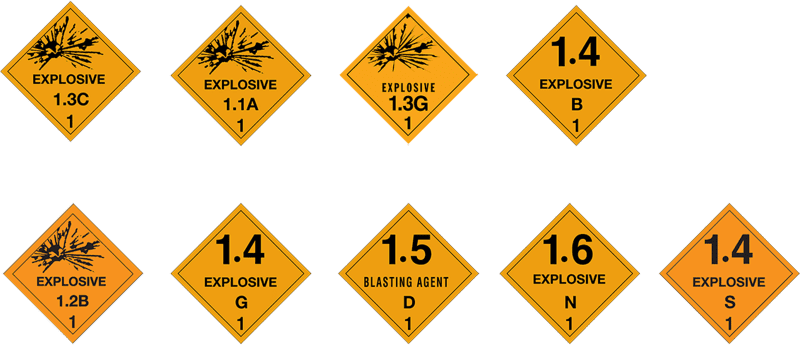

- Class 2.1 – Gases, 2.2 – Flammable Gases, 2.3 – Non-Toxic/Flammable Toxic Gases
- A gas is a substance which:
- at 50°C has a vapour pressure greater than 300 kPa; or
- is completely gaseous at 20°C at a standard pressure of 101.3 kPa.
This class comprises
- compressed gases;
- liquefied gases;
- gases in solution;
- refrigerated liquefied gases;
- mixtures of gases;
- mixtures of one or more gases with one or more vapours of substances of other classes;
- articles charged with a gas;
- tellurium hexafluoride;
- aerosols.
- Class 2 is subdivided further according to the primary hazard of the gas during transport, into:
- Class 2.1 – Flammable gases
- Class 2.2 – Non-flammable, non-toxic gases
- Class 2.3 – Toxic gases


Class 3: Flammable & Combustible Liquids
- These are liquids, or mixtures of liquids, or liquids containing solids in solution or suspension (e.g. paints, varnishes, lacquers, etc., but not including substances which, on account of their other dangerous characteristics, have been included in other classes) which give off a flammable vapour at or below 61°C closed cup test (corresponding to 65.6°C open cup test), normally referred to as the flashpoint.
- Class 3 also includes:
- Liquids offered for transport at temperatures at or above their flashpoint; and
- substances transported or offered for transport at elevated temperatures in a liquid state which give off a flammable vapour at temperatures equal to or below the maximum transport temperature.
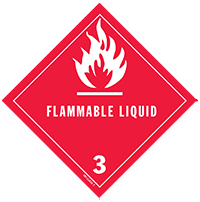

Class 4.1, 4.2, 4.3: Flammable Solids
- Class 4 deals with substances, other than those classed as explosives, which, under conditions of transport, are readily combustible or may contribute to a fire or cause one.
Class 4 is subdivided further, into:
- Class 4.1 – Readily combustible solids and solids which may cause fire through friction; Self-reactive (solids and liquids) and related substances; Desensitized explosives.
- Class 4.2 – Substances liable to spontaneous combustion.
- Class 4.3 – Substances which, in contact with water, emit flammable gases.
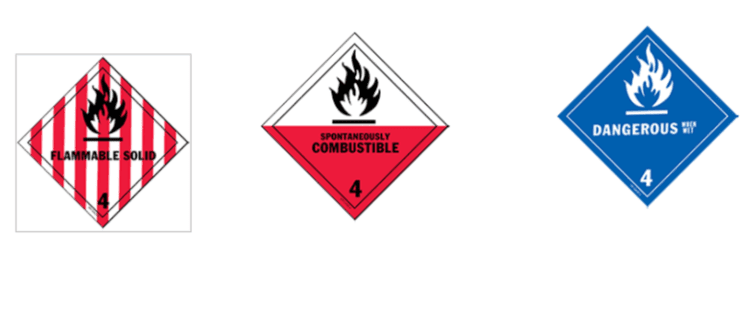

Class 5.1 – Oxidizing Substances, 5.2 – Organic Peroxides
Class 5 is subdivided further, into:
- Class 5.1 – Oxidizing substances (agents). These are substances which, although in themselves not necessarily combustible, may, either by yielding oxygen or by similar processes, increase the risk and intensity of fire in other materials with which they come into contact.
- Class 5.2 – Organic peroxides. Organic peroxides are thermally unstable substances, which may undergo exothermic self-accelerating decomposition. In addition, they may have one or more of the following properties:
- liable to explosive decomposition;
- burn rapidly;
- sensitive to impact or friction;
- react dangerously with other substances;
- cause damage to the eyes.


Class 6.1 – Toxic, 6.2 – Infectious Substances
- Substances that can poison and cause damage to any living body, tissue, and nervous system. “Poisonous” has the same meaning as “toxic”.
Class 6 is subdivided further, into:
- Class 6.1 – Toxic substances. These are substances liable either to cause death or serious injury or to harm human health if swallowed or inhaled, or by skin contact.
- Class 6.2 – Infectious substances. These are substances containing viable micro-organisms, including a bacterium, virus, rickettsia, parasite, fungus or a recombinant, hybrid or mutant, that are known or reasonably believed to cause disease in animals or humans.
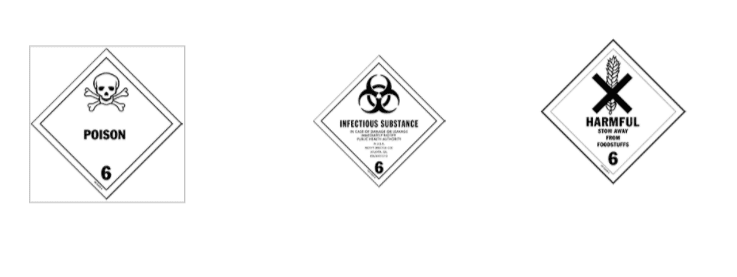

Class 7: Radioactive Material
Radioactive material means any material containing radionuclides where both the activity concentration and the total activity in the consignment exceed the values specified in IMDG code.


Class 8: Corrosives
Class 8 substances (corrosive substances) means substances which, by chemical action, will cause severe damage when in contact with living tissue or, in the case of leakage, will materially damage, or even destroy, other goods or the means of transport. A substance which is designated as “stabilized” should not be transported in the unstabilized state.
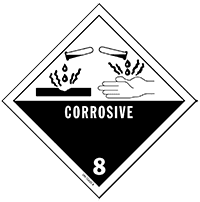

Class 9: Miscellaneous
- Class 9 substances and articles (miscellaneous dangerous substances and articles) comprise:
- Substances and articles not covered by other classes which experience has shown, or may show, to be of such a dangerous character that the provisions of part A of chapter VII of SOLAS, 1974, as amended, should apply; these include substances that are transported or offered for transport at temperatures equal to. or exceeding 100°C, in a liquid state, and solids that are transported or offered for transport at temperatures equal to or exceeding 240°C; and
- Substances not subject to the provisions of part A in chapter VII of the aforementioned Convention, but to which the provisions of Annex III of MARPOL 73/78, as amended, apply.
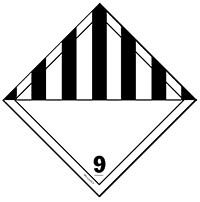

Non-Classified Materials
- A “GENERIC” or “NOT OTHERWISE SPECIFIED (N.O.S)” entry may be used to offer for transport by sea a substance, material or article which is not listed by its name in the Dangerous Goods List. Such a substance, material or article may be transported only after:
- its dangerous, hazardous and/or harmful properties have been determined;
- it has been classified in accordance with the class definitions and criteria; and
- the entry that most accurately describes the nature of the goods has been selected.
- Once the class of the goods has been established, all applicable requirements for transport laid down in the IMDG Code should be complied with.
- Any substance, material or article having, or suspected of having, explosive properties or characteristics should first be considered for classification in class 1.
